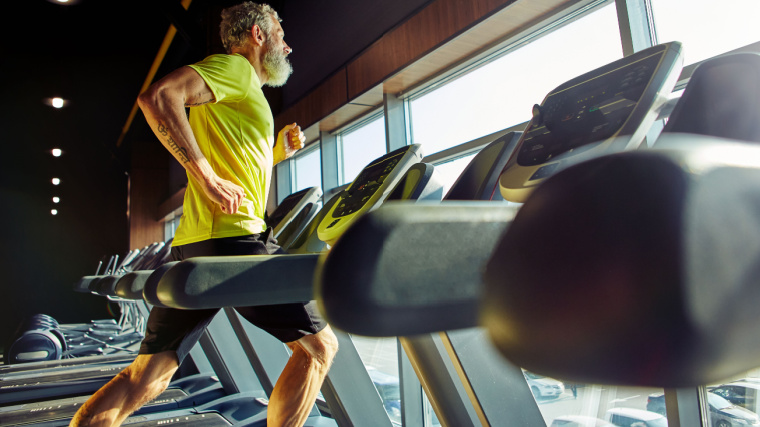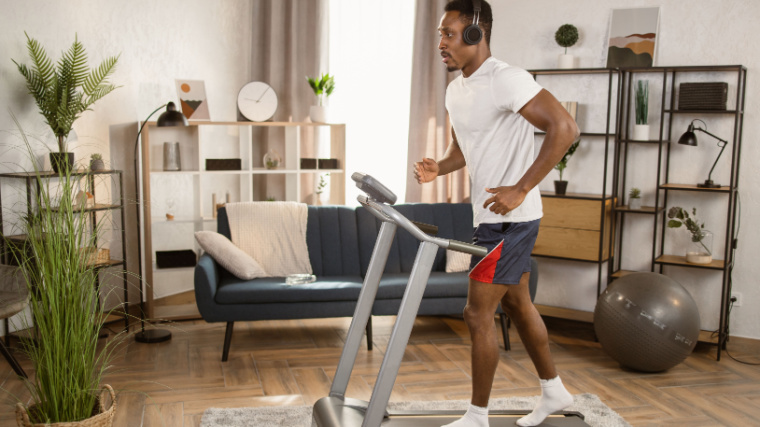Muscle Insider
New member
Given an infinite amount of free time and a perfectly stable climate, you could run anywhere, any time, for however long you want. That may be enticing, but if you’re juggling school, work, ... Read more
The post The Best 30-Minute Treadmill Workout You Can Do to Build Stamina and Strength appeared first on BarBend.
Given an infinite amount of free time and a perfectly stable climate, you could run anywhere, any time, for however long you want. That may be enticing, but if you’re juggling school, work, travel, or family responsibilities, convenient cardio exercises might be hard to come by.
Given the limitations of your busy life, you may need to squeeze in some quick cardio workouts without braving the elements outside. This is no easy task — but it is highly doable. Lace up your running shoes, hop onto the best treadmill you have access to, and dive into a 30-minute treadmill workout.
 Credit: Kostiantyn Voitenko / Shutterstock
Credit: Kostiantyn Voitenko / Shutterstock
It doesn’t have to take long to break a sweat, improve your cardiovascular conditioning and health, and get closer to your fitness goals. Here, you’ll learn how to take control of your half-hour cardio session and reap the biggest gains possible.
Try This 30-minute Treadmill Workout
The beauty of this workout is that you can easily adapt its intensity to match your fitness level and motivation at any given time. Whether you’re aiming to increase your overall wellness, get in a solid interval workout, or drive some weight loss with a calorie-burning boost, you can customize this treadmill workout to meet your needs.
Your Effort Level
Your workout is going to consist of a warm-up, followed by three distinct training phases, and then a final cooldown. This workout is fully customizable to your skills, experience level, and fitness goals.
 Credit: Shutter.B / Shutterstock
Credit: Shutter.B / Shutterstock
[Read More: The Best Online Workout Programs for Coaching, Cardio, Value, and More]
You can make the intervals themselves shorter if need be. Even within the intervals themselves, use your rating of perceived exertion (RPE) to inform your speed and incline. The beauty of using your RPE to guide your workout is that it is highly personalized.
To help you assess your RPE at any given time during your run, here’s how the scale breaks down:
If you feel like the incline or speed you selected is making you work too hard to match the prescribed RPE range, slow down and/or lower your incline.
The Workout
Days: M, W, F or T, Th, Sat
The Warm-up
As with strength training, you’ll need to get your body ready for intense action. Complete a straightforward running warm-up following a dynamic warm-up to wake up your joints and muscles.
 Credit: Chiociolla / Shutterstock
Credit: Chiociolla / Shutterstock
[Read More: 5 At-Home Workouts for Strength, Muscle Growth, Power, and More]
You’ll begin your 30-minute workout by using the treadmill for walking steadily or jogging very slowly. During these two minutes, maintain a low incline — between 0.5 and two — and a low speed. Start to get your heart rate up, but move steadily enough to allow your body to acclimate to your training.
The Liftoff
The first 10 minutes of this workout routine will be spent walking at a slowly escalating speed and incline until you hit a steady jog at RPE four. Every minute, make an adjustment to slightly increase your effort level.
On odd minutes, slowly up your speed, perhaps by 0.1 or 0.2 miles per hour. On even minutes, slightly increase your incline by 0.5 or 1.0, depending on your experience and fitness level. with adjustments made every minute to maintain your engagement.
At that rate, if you commence at an incline of 3.0 and speed of 2.6, you could be walking at an incline of 12.0 and a speed of 3.5 by the conclusion of the 10th minute.
If at any point the pace feels good but the incline is too intense, lower it a little. If you’d prefer to maintain a high incline but need to lower your pace in order to stay in the prescribed RPE range, do that.
Leveling Off
The middle portion of your training is going to be spent jogging and eventually running at a solid RPE seven, slightly faster than a strong 5k pace. During this segment of the workout, your glutes, hamstrings, and calves will really start firing. You’ll be increasing your speed while decreasing your incline across these 10 minutes.
You will begin the jog at a significant incline — whatever that means for you — but as your pace increases by 0.2 MPH every minute, your incline will be reduced by the same interval.
 Credit: SeventyFour / Shutterstock
Credit: SeventyFour / Shutterstock
For instance, if you begin this segment at a jogging speed of 4.0 and an incline of 4.0, then you will be jogging at a speed of 5.8 and an incline of 2.2 after this segment.
Cruising Speed
For the final 10 minutes, you are going to quickly work your way up to a very challenging running speed and back down, all while gradually decreasing the slope of your incline.
If you begin this section at a running speed of 6.0 and an incline of 2.0, you are going to reach a speed of 7.0 and an incline of 1.0 at the five-minute mark.
You’ll be very grateful at the decreasing incline by this point, as your speed will become ever more difficult to maintain. You’ll start at an RPE of six and end the last minute of this segment with an RPE of nine.
The Cool Down
You can finally stop running to kick off your cool down. Begin this segment by walking slowly for the first two minutes, and walking even slower for the last two minutes. Put your hands on your head to open up your chest and breathe deeply to help strengthen your recovery. Then, it’ll be time to congratulate yourself for a well-spent half-hour.
Benefits of Working Out on a Treadmill
You might dread putting on your joggers and heading into the great outdoors for a run. Instead, opt for a treadmill session to help make your workout that much more accessible, both physically and emotionally.
Convenience
There’s no replacement for knowing that you have access to a dry, stable running surface, whether rain or shine. Having outright ownership of a treadmill, or easy access to one at your local gym, means that interruptions like inclement or extreme weather have absolutely no bearing on your workout.
It also means you can choose workout times that might otherwise be compromised by darkness or unsafe conditions. With the press of a button, you can take breaks — or fire up the turbo jets — quickly and easily.
 Credit: SofikoS / Shutterstock
Credit: SofikoS / Shutterstock
[Read More: How to Become a Morning (Workout) Person]
Athletes who prefer to train privately may also appreciate the solitary nature of a home gym with a treadmill.
Customizable Workouts
Whether you’re running outside on the pavement, or indoors on a fixed track, you can’t control the slope and layout of the path. On the other hand (or foot), a treadmill allows you to set the incline of your terrain, along with your speed. You’ll know how fast and how far you’re going at all times (even if you don’t have a fitness tracker).
[Read More: The 7 Best Smart Home Gyms]
This control lets you customize your training landscape. If you want to do hill runs in a distinctly flat neighborhood, the treadmill lets you do so. And if the local hills are too steep for your current fitness level or are otherwise unsafe to run on, you can adjust to the desired slope on your trust treadmill.
Adaptability
Not only can your treadmill sustain a fixed speed and incline, but you can also adjust these attributes of your workout on the fly. Whether the challenge is overwhelming or insufficient, both of these frustrations can be overcome by a few presses of the appropriate buttons on the control panel.
On the artificial raceway provided by a treadmill, you can drop a daunting hill in your path out of the clear blue sky, or make one disappear in a flash. The choice is entirely yours.
Different Types of Cardio Explained
In its simplest form, cardio is short for cardiovascular. The typical definition applies to any form of training that is meant to offer a sustained challenge to your heart and lungs.
https://youtube.com/watch?v=e0eR4J8l0_4Video can’t be loaded because JavaScript is disabled: NordicTrack 1750 Treadmill Review (2022) — BEST Of The Best? (https://youtube.com/watch?v=e0eR4J8l0_4)
[Read More: 10 Science-Backed Benefits of Walking for Strength Athletes]
When it comes to foot-based travel, every method of steady movement can qualify as cardio if it sufficiently elevates your heart rate. In terms of what you can do on the treadmill, there are a few common methods of cardiovascular training to choose from.
Walking
Technically, all walking is a controlled fall. But walking (as opposed to jogging or running) typically maintains one foot on the ground at all times. It’s a much slower pace to maintain than running or even jogging.
Furthermore, walking is also presumed to take place at speeds at or below 3.5 miles per hour (or RPE of one or two). While walking is certainly a low-impact form of training, it can be very challenging, especially when it is performed at a high speed and steep incline for extended periods. In those cases, your RPE can certainly rise above two and still be walking.
Jogging
Jogging occurs at a transitional, intermediary state that constitutes a harder effort than walking but a slower, less high-impact effort than running. Think of jogging as maintaining an RPE between three and four.
Your knees will bend much more than they will during walking, and you’ll propel yourself farther with each step. Jogging is more similar in form to running than to walking, but you’re still maintaining a relatively easy pace that you can sustain for longer than a full run.
Running
Running involves a much greater knee bend than waking and a faster pace than jogging. Neither of your feet are in contact with the ground except during your actual stride. Although it might be tempting to slam your feet, thinking it might propel you faster, try to stay light on your feet while running, landing as gently as you can.
 Credit: Dusan Petkovic / Shutterstock
Credit: Dusan Petkovic / Shutterstock
[Read More: The 8 Best Budget Treadmills]
On a treadmill, the transition between jogging and running often occurs for people between five and six miles per hour (a 5.0 and 6.0 on the pace indicator). Running generally calls for an RPE of five or greater, with talking becoming increasingly difficult as you increase your pace.
High-Intensity Interval Training
High-intensity interval training (HIIT) is a common form of cardiovascular training where the working intervals have you giving a nine or 10 RPE effort.
HIIT workouts involve short intervals of intense work — often less than 30 seconds — followed by regular periods of either rest or reduced-intensity work. The idea is to train yourself to produce all-out efforts multiple times, improving your ability to quickly recover as you do so.
Fartlek Training
Derived from the Swedish word for speed play, fartlek training involves the often unplanned and unstructured transition from one speed to another. The speed shift can be dictated by a length of time or a specific distance that you wish to cover at each speed. The trick is that you’ll be jogging at all times — no walking if you can avoid it.
A classic instance of a fartlek run around a track might involve sprinting 100 meters, slowly walking or jogging 300 meters, and then sprinting 50 meters, all without stopping.
 Credit: Frau aus UA / Shutterstock
Credit: Frau aus UA / Shutterstock
[Read More: What You Need to Know About Muscle Recovery]
If you’re doing a fartlek run on a treadmill, some of your hard effort intervals might last 30 seconds. That will be followed by a 30-second jogging recovery. Other intervals might be a three-minute solid run followed by a four-minute slow jog — all in the same workout.
It’s Only 30 Minutes
If you have cardio gains on the brain, try carving out just 30 minutes of your day. You can improve the durability of your heart and lungs while adding some serious endurance to your legs. Like most achievements that are worthwhile, conquering a 30-minute treadmill workout will present a tremendous challenge but satisfying gains.
Fortunately, something incredible awaits you after your training: A body (and mind) capable of handling anything that life may throw at it, whether you’re on or off the treadmill.
FAQs
New to treadmill running as a form of training? You’re bound to have questions about the best way to train on a treadmill. Here are some answers that we hope will satisfy your curiosity and kickstart your training.
Is 30 minutes on the treadmill good? Under most circumstances, 30 minutes is more than adequate for cardiovascular training. Unless you are preparing yourself to run distances significantly greater than you can cover in half an hour, 30 minutes is plenty of time to carry out a productive and efficient workout.
What is the 12-3-30 treadmill workout? The 12-3-30 treadmill workout is a straightforward protocol that was popularized by social media influencer Lauren Giraldo. It requires you to set your treadmill at an incline of 12, pair it with a speed of three miles per hour, and then walk for 30 minutes.
What type of treadmill workout should you do if you want to burn calories? Theoretically, the treadmill workout that will burn the most calories will be a program where you run as fast as you can, at the steepest incline you can, for as long as you can sustain it.
Due to the difficulty of engaging in such a training program over both the short and long term, treadmill workouts that incorporate reduced speeds and lower inclines are commonplace. These will also offer significant calorie burning without the same risk of burning you out.
{"@context":"https://schema.org","@type":"FAQPage","mainEntity":[{"@type":"Question","name":"Is 30 minutes on the treadmill good?u00a0","acceptedAnswer":{"@type":"Answer","text":"Under most circumstances, 30 minutes is more than adequate for cardiovascular training. Unless you are preparing yourself to run distances significantly greater than you can cover in half an hour, 30 minutes is plenty of time to carry out a productive and efficient workout.
n"}},{"@type":"Question","name":"What is the 12-3-30 treadmill workout?u00a0","acceptedAnswer":{"@type":"Answer","text":"The 12-3-30 treadmill workout is a straightforward protocol that was popularized by social media influencer Lauren Giraldo. It requires you to set your treadmill at an incline of 12, pair it with a speed of three miles per hour, and then walk for 30 minutes.
n"}},{"@type":"Question","name":"What type of treadmill workout should you do if you want to burn calories?u00a0","acceptedAnswer":{"@type":"Answer","text":"Theoretically, the treadmill workout that will burn the most calories will be a program where you run as fast as you can, at the steepest incline you can, for as long as you can sustain it.
nDue to the difficulty of engaging in such a training program over both the short and long term, treadmill workouts that incorporate reduced speeds and lower inclines are commonplace. These will also offer significant calorie burning without the same risk of burning you out.
n"}}]}
Featured Image: Kostiantyn Voitenko / Shutterstock
The post The Best 30-Minute Treadmill Workout You Can Do to Build Stamina and Strength appeared first on BarBend.
Click here to view the article.
The post The Best 30-Minute Treadmill Workout You Can Do to Build Stamina and Strength appeared first on BarBend.
Given an infinite amount of free time and a perfectly stable climate, you could run anywhere, any time, for however long you want. That may be enticing, but if you’re juggling school, work, travel, or family responsibilities, convenient cardio exercises might be hard to come by.
Given the limitations of your busy life, you may need to squeeze in some quick cardio workouts without braving the elements outside. This is no easy task — but it is highly doable. Lace up your running shoes, hop onto the best treadmill you have access to, and dive into a 30-minute treadmill workout.
 Credit: Kostiantyn Voitenko / Shutterstock
Credit: Kostiantyn Voitenko / ShutterstockIt doesn’t have to take long to break a sweat, improve your cardiovascular conditioning and health, and get closer to your fitness goals. Here, you’ll learn how to take control of your half-hour cardio session and reap the biggest gains possible.
Try This 30-minute Treadmill Workout
The beauty of this workout is that you can easily adapt its intensity to match your fitness level and motivation at any given time. Whether you’re aiming to increase your overall wellness, get in a solid interval workout, or drive some weight loss with a calorie-burning boost, you can customize this treadmill workout to meet your needs.
Your Effort Level
Your workout is going to consist of a warm-up, followed by three distinct training phases, and then a final cooldown. This workout is fully customizable to your skills, experience level, and fitness goals.
 Credit: Shutter.B / Shutterstock
Credit: Shutter.B / Shutterstock[Read More: The Best Online Workout Programs for Coaching, Cardio, Value, and More]
You can make the intervals themselves shorter if need be. Even within the intervals themselves, use your rating of perceived exertion (RPE) to inform your speed and incline. The beauty of using your RPE to guide your workout is that it is highly personalized.
To help you assess your RPE at any given time during your run, here’s how the scale breaks down:
- RPE 10 — An all-out sprint; you can’t sustain this speed longer than 10 to 30 seconds.
- RPE 9 — Your max speed for a one-minute interval; you’re breathing heavily after only a few seconds.
- RPE 8 — A hard, strong effort, but not a sprint; a challenging mile pace.
- RPE 7 — A strong effort, requiring intense focus to maintain; you may be able to speak in short sentences.
- RPE 6 — A challenging but sustainable effort; you can run a strong 5k at this pace.
- RPE 5 — A steady running effort where you can carry on a conversation but still requires you to push yourself; your best 10k pace.
- RPE 4 — A jogging pace where you’re pushing yourself, but very gently; you can easily speak a few short sentences.
- RPE 3 — You’re comfortable and warming up at this slow jogging pace; you can converse with your gym buddy without struggling or being out of breath.
- RPE 2 — A very gentle walking pace where you can easily converse at length; you could sustain this pace for hours.
- RPE 1 — You’re taking a stroll rather than walking with effort; if you had to walk all day, this would be your pace.
If you feel like the incline or speed you selected is making you work too hard to match the prescribed RPE range, slow down and/or lower your incline.
The Workout
Days: M, W, F or T, Th, Sat
- The Warm-Up: Walking for two minutes at a low incline, RPE 2
- The Liftoff: Walking for 10 minutes at steadily increasing inclines of low to very high, RPE 3-4
- Leveling Off: Jogging and running for 10 minutes at an increasing speed and a gradually lowering incline, RPE 5-7
- Cruising Speed: Running for 10 minutes at a fluctuating speed and a low incline, RPE 6-9
- The Cooldown: Walking for four minutes at a slow speed and a very low incline, RPE 1-2
The Warm-up
As with strength training, you’ll need to get your body ready for intense action. Complete a straightforward running warm-up following a dynamic warm-up to wake up your joints and muscles.
 Credit: Chiociolla / Shutterstock
Credit: Chiociolla / Shutterstock[Read More: 5 At-Home Workouts for Strength, Muscle Growth, Power, and More]
You’ll begin your 30-minute workout by using the treadmill for walking steadily or jogging very slowly. During these two minutes, maintain a low incline — between 0.5 and two — and a low speed. Start to get your heart rate up, but move steadily enough to allow your body to acclimate to your training.
The Liftoff
The first 10 minutes of this workout routine will be spent walking at a slowly escalating speed and incline until you hit a steady jog at RPE four. Every minute, make an adjustment to slightly increase your effort level.
On odd minutes, slowly up your speed, perhaps by 0.1 or 0.2 miles per hour. On even minutes, slightly increase your incline by 0.5 or 1.0, depending on your experience and fitness level. with adjustments made every minute to maintain your engagement.
At that rate, if you commence at an incline of 3.0 and speed of 2.6, you could be walking at an incline of 12.0 and a speed of 3.5 by the conclusion of the 10th minute.
If at any point the pace feels good but the incline is too intense, lower it a little. If you’d prefer to maintain a high incline but need to lower your pace in order to stay in the prescribed RPE range, do that.
Leveling Off
The middle portion of your training is going to be spent jogging and eventually running at a solid RPE seven, slightly faster than a strong 5k pace. During this segment of the workout, your glutes, hamstrings, and calves will really start firing. You’ll be increasing your speed while decreasing your incline across these 10 minutes.
You will begin the jog at a significant incline — whatever that means for you — but as your pace increases by 0.2 MPH every minute, your incline will be reduced by the same interval.
 Credit: SeventyFour / Shutterstock
Credit: SeventyFour / ShutterstockFor instance, if you begin this segment at a jogging speed of 4.0 and an incline of 4.0, then you will be jogging at a speed of 5.8 and an incline of 2.2 after this segment.
Cruising Speed
For the final 10 minutes, you are going to quickly work your way up to a very challenging running speed and back down, all while gradually decreasing the slope of your incline.
If you begin this section at a running speed of 6.0 and an incline of 2.0, you are going to reach a speed of 7.0 and an incline of 1.0 at the five-minute mark.
You’ll be very grateful at the decreasing incline by this point, as your speed will become ever more difficult to maintain. You’ll start at an RPE of six and end the last minute of this segment with an RPE of nine.
The Cool Down
You can finally stop running to kick off your cool down. Begin this segment by walking slowly for the first two minutes, and walking even slower for the last two minutes. Put your hands on your head to open up your chest and breathe deeply to help strengthen your recovery. Then, it’ll be time to congratulate yourself for a well-spent half-hour.
Benefits of Working Out on a Treadmill
You might dread putting on your joggers and heading into the great outdoors for a run. Instead, opt for a treadmill session to help make your workout that much more accessible, both physically and emotionally.
Convenience
There’s no replacement for knowing that you have access to a dry, stable running surface, whether rain or shine. Having outright ownership of a treadmill, or easy access to one at your local gym, means that interruptions like inclement or extreme weather have absolutely no bearing on your workout.
It also means you can choose workout times that might otherwise be compromised by darkness or unsafe conditions. With the press of a button, you can take breaks — or fire up the turbo jets — quickly and easily.
 Credit: SofikoS / Shutterstock
Credit: SofikoS / Shutterstock[Read More: How to Become a Morning (Workout) Person]
Athletes who prefer to train privately may also appreciate the solitary nature of a home gym with a treadmill.
Customizable Workouts
Whether you’re running outside on the pavement, or indoors on a fixed track, you can’t control the slope and layout of the path. On the other hand (or foot), a treadmill allows you to set the incline of your terrain, along with your speed. You’ll know how fast and how far you’re going at all times (even if you don’t have a fitness tracker).
[Read More: The 7 Best Smart Home Gyms]
This control lets you customize your training landscape. If you want to do hill runs in a distinctly flat neighborhood, the treadmill lets you do so. And if the local hills are too steep for your current fitness level or are otherwise unsafe to run on, you can adjust to the desired slope on your trust treadmill.
Adaptability
Not only can your treadmill sustain a fixed speed and incline, but you can also adjust these attributes of your workout on the fly. Whether the challenge is overwhelming or insufficient, both of these frustrations can be overcome by a few presses of the appropriate buttons on the control panel.
On the artificial raceway provided by a treadmill, you can drop a daunting hill in your path out of the clear blue sky, or make one disappear in a flash. The choice is entirely yours.
Different Types of Cardio Explained
In its simplest form, cardio is short for cardiovascular. The typical definition applies to any form of training that is meant to offer a sustained challenge to your heart and lungs.
https://youtube.com/watch?v=e0eR4J8l0_4Video can’t be loaded because JavaScript is disabled: NordicTrack 1750 Treadmill Review (2022) — BEST Of The Best? (https://youtube.com/watch?v=e0eR4J8l0_4)
[Read More: 10 Science-Backed Benefits of Walking for Strength Athletes]
When it comes to foot-based travel, every method of steady movement can qualify as cardio if it sufficiently elevates your heart rate. In terms of what you can do on the treadmill, there are a few common methods of cardiovascular training to choose from.
Walking
Technically, all walking is a controlled fall. But walking (as opposed to jogging or running) typically maintains one foot on the ground at all times. It’s a much slower pace to maintain than running or even jogging.
Furthermore, walking is also presumed to take place at speeds at or below 3.5 miles per hour (or RPE of one or two). While walking is certainly a low-impact form of training, it can be very challenging, especially when it is performed at a high speed and steep incline for extended periods. In those cases, your RPE can certainly rise above two and still be walking.
Jogging
Jogging occurs at a transitional, intermediary state that constitutes a harder effort than walking but a slower, less high-impact effort than running. Think of jogging as maintaining an RPE between three and four.
Your knees will bend much more than they will during walking, and you’ll propel yourself farther with each step. Jogging is more similar in form to running than to walking, but you’re still maintaining a relatively easy pace that you can sustain for longer than a full run.
Running
Running involves a much greater knee bend than waking and a faster pace than jogging. Neither of your feet are in contact with the ground except during your actual stride. Although it might be tempting to slam your feet, thinking it might propel you faster, try to stay light on your feet while running, landing as gently as you can.
 Credit: Dusan Petkovic / Shutterstock
Credit: Dusan Petkovic / Shutterstock[Read More: The 8 Best Budget Treadmills]
On a treadmill, the transition between jogging and running often occurs for people between five and six miles per hour (a 5.0 and 6.0 on the pace indicator). Running generally calls for an RPE of five or greater, with talking becoming increasingly difficult as you increase your pace.
High-Intensity Interval Training
High-intensity interval training (HIIT) is a common form of cardiovascular training where the working intervals have you giving a nine or 10 RPE effort.
HIIT workouts involve short intervals of intense work — often less than 30 seconds — followed by regular periods of either rest or reduced-intensity work. The idea is to train yourself to produce all-out efforts multiple times, improving your ability to quickly recover as you do so.
Fartlek Training
Derived from the Swedish word for speed play, fartlek training involves the often unplanned and unstructured transition from one speed to another. The speed shift can be dictated by a length of time or a specific distance that you wish to cover at each speed. The trick is that you’ll be jogging at all times — no walking if you can avoid it.
A classic instance of a fartlek run around a track might involve sprinting 100 meters, slowly walking or jogging 300 meters, and then sprinting 50 meters, all without stopping.
 Credit: Frau aus UA / Shutterstock
Credit: Frau aus UA / Shutterstock[Read More: What You Need to Know About Muscle Recovery]
If you’re doing a fartlek run on a treadmill, some of your hard effort intervals might last 30 seconds. That will be followed by a 30-second jogging recovery. Other intervals might be a three-minute solid run followed by a four-minute slow jog — all in the same workout.
It’s Only 30 Minutes
If you have cardio gains on the brain, try carving out just 30 minutes of your day. You can improve the durability of your heart and lungs while adding some serious endurance to your legs. Like most achievements that are worthwhile, conquering a 30-minute treadmill workout will present a tremendous challenge but satisfying gains.
Fortunately, something incredible awaits you after your training: A body (and mind) capable of handling anything that life may throw at it, whether you’re on or off the treadmill.
FAQs
New to treadmill running as a form of training? You’re bound to have questions about the best way to train on a treadmill. Here are some answers that we hope will satisfy your curiosity and kickstart your training.
Is 30 minutes on the treadmill good? Under most circumstances, 30 minutes is more than adequate for cardiovascular training. Unless you are preparing yourself to run distances significantly greater than you can cover in half an hour, 30 minutes is plenty of time to carry out a productive and efficient workout.
What is the 12-3-30 treadmill workout? The 12-3-30 treadmill workout is a straightforward protocol that was popularized by social media influencer Lauren Giraldo. It requires you to set your treadmill at an incline of 12, pair it with a speed of three miles per hour, and then walk for 30 minutes.
What type of treadmill workout should you do if you want to burn calories? Theoretically, the treadmill workout that will burn the most calories will be a program where you run as fast as you can, at the steepest incline you can, for as long as you can sustain it.
Due to the difficulty of engaging in such a training program over both the short and long term, treadmill workouts that incorporate reduced speeds and lower inclines are commonplace. These will also offer significant calorie burning without the same risk of burning you out.
{"@context":"https://schema.org","@type":"FAQPage","mainEntity":[{"@type":"Question","name":"Is 30 minutes on the treadmill good?u00a0","acceptedAnswer":{"@type":"Answer","text":"Under most circumstances, 30 minutes is more than adequate for cardiovascular training. Unless you are preparing yourself to run distances significantly greater than you can cover in half an hour, 30 minutes is plenty of time to carry out a productive and efficient workout.
n"}},{"@type":"Question","name":"What is the 12-3-30 treadmill workout?u00a0","acceptedAnswer":{"@type":"Answer","text":"The 12-3-30 treadmill workout is a straightforward protocol that was popularized by social media influencer Lauren Giraldo. It requires you to set your treadmill at an incline of 12, pair it with a speed of three miles per hour, and then walk for 30 minutes.
n"}},{"@type":"Question","name":"What type of treadmill workout should you do if you want to burn calories?u00a0","acceptedAnswer":{"@type":"Answer","text":"Theoretically, the treadmill workout that will burn the most calories will be a program where you run as fast as you can, at the steepest incline you can, for as long as you can sustain it.
nDue to the difficulty of engaging in such a training program over both the short and long term, treadmill workouts that incorporate reduced speeds and lower inclines are commonplace. These will also offer significant calorie burning without the same risk of burning you out.
n"}}]}
Featured Image: Kostiantyn Voitenko / Shutterstock
The post The Best 30-Minute Treadmill Workout You Can Do to Build Stamina and Strength appeared first on BarBend.
Click here to view the article.

